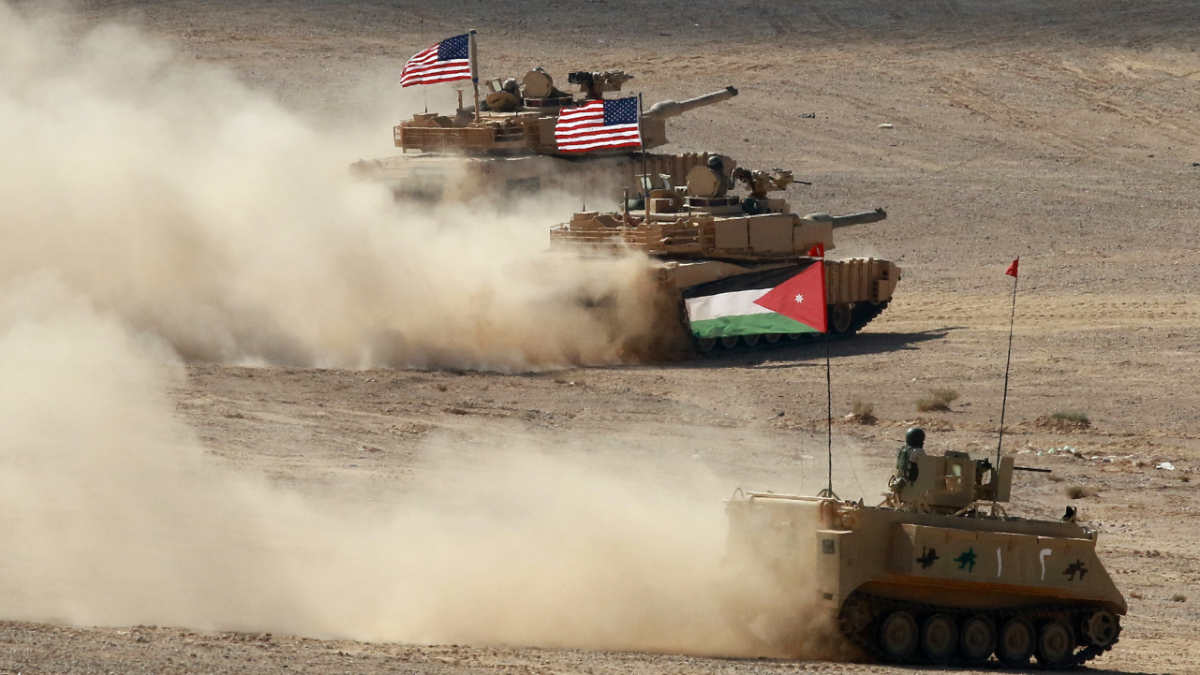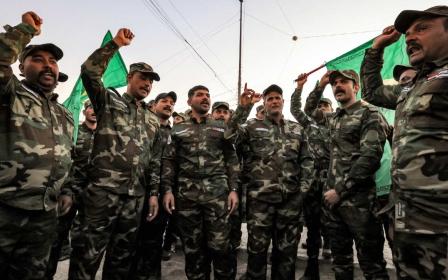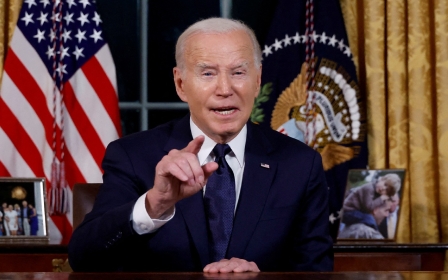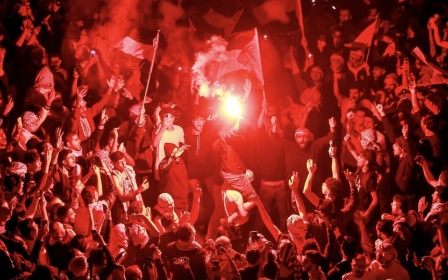War on Gaza: US officials see Iran escalating proxy war into uncharted terrain with Jordan strike

A deadly drone attack by an Iranian-backed militia on a US outpost in Jordan is raising questions in Washington about how far Iran and its allies will go in their bid to expel US troops from the region, as they force the Biden administration’s hand to conduct a powerful retaliatory strike that threatens to widen the Gaza war.
The attack that killed three US soldiers and wounded more than 40 more came just as some officials in Washington assessed that leadership in Tehran and Iran's Quds Force were looking to reduce attacks on US assets, according to current and former US officials who spoke with Middle East Eye on condition of anonymity. The Quds Force is a branch of the Islamic Revolutionary Guard Corps that operates as a special operations unit.
Over the weekend, Iran and its Iraqi allies inched closer to a long-term goal of expelling US troops from Iraq, when the Biden administration held its first talks with Baghdad on a planned withdrawal of the US-led mission to counter the Islamic State militant (IS) group in the country.
Just as those discussions were underway, CIA director Bill Burns was sitting down in Paris to hammer out the details of a proposal for a months-long pause in Gaza fighting with Arab and Israeli counterparts.
Qatar’s prime minister said on Monday that the deal could lay the framework for a lengthy ceasefire in the war in Gaza, a resolution that western officials tell MEE could leave Hamas degraded but alive, preserving one of the nodes in Tehran’s so-called "axis of resistance".
But the attack on Tower 22, a small US base in a desolate sliver of northeastern Jordan, now has US officials scrambling to determine whether Tehran sees the Gaza war as an opportunity to expand the conflict with the US outside established zones like Syria and Iraq and into previously uncharted terrain.
Iranian-backed militias have launched more than 150 attacks on US forces in the region since 7 October when the war between Palestine and Israel began.
Sunday's attack in Jordan was in many ways no different from the others, except for the fact that it killed American soldiers.
Air defence systems at the base were not activated in time because the enemy drone was confused for an incoming friendly one, US officials said.
Jordan is a stalwart US ally that is considered a safe harbour for American soldiers and diplomats. Striking inside the Hashemite Kingdom suggests that Iran and its partners appear willing to broaden their battlefield with the US, current and former US officials tell MEE.
Bruce Riedel, a former senior Middle East analyst for the CIA and expert on Jordan-US ties, told MEE that US troops at Tower 22 would have been more relaxed than their counterparts 20 kilometres away at al-Tanf base in Syria, which also was targeted by Iranian-backed militias the same day.
“The Iranians and their allies have been trying to find an American base that they can hit. Going into Jordanian territory is a serious escalation,” Riedel said.
In the ladder of tit-for tat strikes the US and Iran have extracted against each other since 7 October, the first known attack in Jordan - and death of three US soldiers - marks a turning point.
On Monday, US Secretary of Antony Blinken said the situation in the Middle East was now the most “dangerous” since at least 1973, a reference to the Arab-Israeli war when the US went to Defcon three, the highest alert level during peacetime.
Jordan has long been a stable fallback for the US in its campaign against IS and efforts to check Iran’s expansion in the Levant, and its Muwaffaq Salti Air Base is a key hub for US drones and fighter jets.
'A secondary goal was to destabilise Jordan'
- Bruce Riedel, Former CIA analyst
At least 3,000 US troops operate in the Hashemite Kingdom, which has a defence agreement with Washington that allows them “unimpeded access” to many Jordanian military facilities.
Following the US withdrawal from Afghanistan, the US relocated stores of weapons and ammunition held in Qatar to Jordan.
Amman is dependent on the US for economic aid, but its military ties to Washington are unpopular at home. In 2021, Jordan's King Abdullah 11 bypassed parliament in order to seal the US defence agreement.
Domestic pressure on Jordan’s king over his close ties to the US has only grown since the war in Gaza erupted. Hamas's popularity in Jordan has soared and calls have grown for Amman to sever its peace treaty with Israel.
“The main purpose of this strike was to hit at the US, but a secondary goal was to destabilise Jordan,” Riedel said, adding that Amman’s denial that the attack occurred on its soil was an attempt to downplay its close security ties to Washington.
'Wasteland war'
The war in Gaza has been gradually seeping out beyond the besieged Mediterranean enclave’s borders. In Lebanon, Hezbollah and Israel are exchanging near daily fire, while in Yemen, the US has launched air strikes in response to the Houthis' attacks on commercial shipping.
But the attack on Tower 22 reveals a little-known side to the deadly proxy war raging between Washington and Tehran. It’s being fought in Jordan’s desert periphery, along the borders of Syria and Iraq, in a terrain one former US official described as a "wasteland".
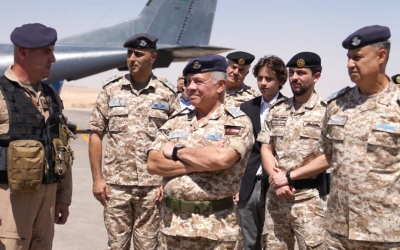
“Everyone is operating here,” Adam Clements, a former US Army attache in Jordan told MEE. “The Russians, the IRGC, and Iranian-backed militias.”
While Tower 22 was largely unknown in the West until the strike, Clements said US adversaries in the region knew the US was using the base as a logistics and support hub for American troops in Syria.
“It’s well known that this is where a lot of our efforts to train and equip counter-IS forces takes place.”
Jordan has been battling a booming drug smuggling trade along its border for years. Experts and western officials say it is controlled by the government of Bashar al-Assad and Iranian-linked militias.
Since the war in Gaza erupted, fighting with the smugglers along the border has skyrocketed, Saud al-Sharafat, a former brigadier general in the Jordanian General Intelligence Directorate, told MEE.
“The situation is very tense,” Sharafat said. “The army is not just fighting drug smugglers, but militias.”
Sharafat said Iranian-backed groups in Syria are using drones to target Jordanian troops and also smuggle weapons destined for Palestinian fighters in the occupied West Bank.
Jordan publicly asked the US to deploy Patriot missile systems to the country at the start of the Gaza war to bolster its defences.
The fighting peaked in December when a Jordanian officer was killed in a firefight with armed smugglers. Jordan later said it foiled an attempt by an Iran-linked militia to break through its border with rocket launchers and anti-personnel mines.
Jordan responded by launching unprecedented air strikes in Syria.
Sharafat said the strike on Tower 22 was a “double blow” designed to kill US soldiers, but also “punish Jordan” for the air strikes.
Merissa Khurma, director of the Middle East programme at the Wilson Center, told MEE she wasn’t surprised Iranian-backed groups had targeted US troops in Jordan, saying it was a “culmination” of the simmering border tensions that have fallen below the radar in the US amid a focus on other fronts.
“The Iranians are aware of the pressure Jordan is facing,” she told MEE, adding that destabilising the kingdom was “on the top" of Iran's list.
'Deterrence has failed'
While Iran has sought to distance itself from the attack, Washington has placed the blame on “radical Iran-backed militant groups” and has promised a “consequential" response.
“We know this is an IRGC-backed militia. It has the footprints of Kataib Hezbollah, but not making a final assessment on that,” Pentagon spokesperson Sabrina Singh said Monday, referring to an Iran-backed paramilitary group in Iraq.
The Islamic Resistance in Iraq, a shadowy umbrella group of Iranian-backed militias, claimed responsibility for three attacks, including at al-Tanf base, which is near Tower 22.
The US has retaliated to attacks on its forces by striking Iranian-linked groups in Iraq and Syria.
Some Republican lawmakers have accused the Biden administration of a tepid response to attacks on US forces in the region and have called for direct strikes on Iranian soil or troops in response to the Tower 22 attack.
'Whatever forces the US has deployed in the region for deterrence against Iran have clearly failed... The Biden administration has to take a firm response'
- Merissa Khurma, Wilson Center
The Biden administration on Tuesday said it has decided how to respond and that it holds Iran responsible for the attack, but "in the sense that they're supplying the weapons to the people who did it". Biden reiterated during the same statement that the US is not seeking a wider war in the Middle East.
Shortly after the administration's statement, Kataib Hezbollah announced that it would halt military and security actions against US forces, saying it took the action to prevent "embarrassment" to Iraq's government.
Current and former US officials tell MEE a direct strike on Iran is unlikely.
Because Iran is the dominant power in Syria and Iraq, the US has a range of targets available. One former US official said the US could strike senior Revolutionary Guard officials or leading paramilitary commanders, in a move similar to the Trump administration’s killing of famed Iranian commander, Qassem Soleimani.
A top Hezbollah official, Mohammad Hussein al-Kawtharani, who has been coordinating efforts to drive the US out of Iraq, could be a target, the former official said.
The US is also likely to strike weapons storage facilities and drone production sites. It could also ramp up sanctions enforcement against Tehran, which the Biden administration discreetly relaxed before the war in Gaza.
“Whatever forces the US has deployed in the region for deterrence against Iran have clearly failed,” Khurma said.
“The Biden administration has to take a firm response.”
Middle East Eye propose une couverture et une analyse indépendantes et incomparables du Moyen-Orient, de l’Afrique du Nord et d’autres régions du monde. Pour en savoir plus sur la reprise de ce contenu et les frais qui s’appliquent, veuillez remplir ce formulaire [en anglais]. Pour en savoir plus sur MEE, cliquez ici [en anglais].


